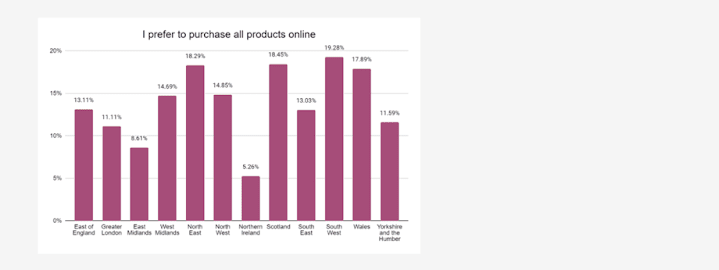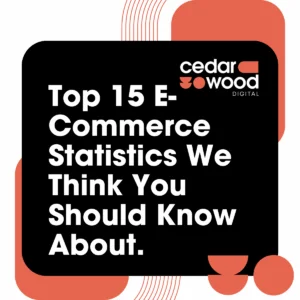E-commerce refers to the process of selling goods or services across international borders from a business’s home country, typically where it was founded or incorporated. These transactions are carried out through digital platforms, allowing companies to reach and sell to customers in overseas markets (Shopify).
Key benefits of international e-commerce include (Shopify):
- Simplified entry into global markets
- Faster identification of demand and market alignment
- Reduced B2B sales timelines
- Accelerated growth of brand presence worldwide
- Fewer obstacles to market entry compared to traditional expansion methods
With the UK leading Europe in both advanced infrastructure and profitability within the e-commerce sector, online shopping has firmly established itself as the standard for consumers nationwide. By 2024, the number of e-commerce users in the country is projected to reach around 50 million, making non-digital shoppers a clear minority (Statista).
- 70% of consumers anticipate personalised experiences (Limely).
Personalisation is becoming a major priority for consumers, with projections indicating that by 2025, 70% will expect tailored experiences. Shoppers want brands to understand their purchasing behaviours, favourite products, and style choices, and to offer customised search results on e-commerce platforms. To keep up with these rising demands, it’s essential to implement advanced features like intelligent search, dynamic product recommendations, and AI-driven tools that enhance the shopping experience and meet customer expectations effectively.
- UK e-commerce is rebounding after a pandemic-driven surge and a brief decline (Statista).
In 2020, following the coronavirus pandemic, internet retail sales in the UK surged by 47 per cent, the fastest growth seen in the past decade. However, this rapid increase was followed by a decline in e-commerce retail sales in 2022, likely due to inflation and other global challenges. Despite this setback, 2023 has shown signs of recovery, and e-commerce revenue in the UK is expected to continue growing steadily across all sectors in the years to come.
- Fashion remains the largest e-commerce sector in the UK (Statista).
Online retail is especially dominant in the fashion sector, which consistently generates the highest revenue among all measured categories each year. According to the latest government data, more than a quarter of retail sales in textile, clothing, and footwear stores come from online channels. Following fashion, food, and consumer electronics are the next top-grossing categories, with major brands like Tesco, Just Eat, Amazon, and Apple leading their industries.
- By 2033, social commerce is projected to grow to $13 trillion (Limley).
Social commerce is poised for explosive growth, expected to soar from its current $1.2 trillion valuation to a staggering $13 trillion by 2033. This massive expansion underscores the critical role social commerce will play for e-commerce brands in the near future. If your business hasn’t integrated social commerce strategies yet, now is the perfect moment to act. The rise of platforms like TikTok Shop and the booming success of Instagram Shopping offer compelling proof of their potential. And if that isn’t enough to convince you, these impressive figures certainly should be the motivation to dive in and capitalise on this rapidly evolving landscape.
- Facebook ranks as the leading social media platform for social commerce transactions (Forbes).
With so many social media platforms available, not all are equally effective for online selling. Around 51% of survey participants reported using Facebook for online purchases, so it’s important to consider this when choosing which platforms to focus on.
- UK E-commerce statistics by geographic location (Space and Time).
As shown by the graph, people in the South West, Scotland, and the North East show a stronger preference for buying products online (Space and Time).

- The UK has nearly 60 million e-commerce users (Space and Time)
Space and Time analysed e-Commerce Trends Over Time in the UK and found that in 2023, the UK had nearly 60 million e-commerce users, a number expected to grow by an additional million by 2025. This growth underscores the UK’s position as the third-largest e-commerce market in the world, following only China and the USA.

- Search Engine Results rank the highest percentage of UK audits (Space and Time).
| Method | Percentage of UK audits |
| Search engine results | 37.88% |
| Friends or family | 34.01% |
| Social media ads | 23.00% |
| Recommendations from online retailers | 18.94% |
| I never discover or purchase new products. | 16.56% |
| Email newsletters | 14.13% |
| Influencer indorsements | 9.32% |
| Other | 2.48% |
As you can see, they found that:
Search engine results lead the way, with 38% of people citing them as their primary method for discovering new brands or products, emphasising the crucial role SEO plays for e-commerce businesses. Despite the rise of digital marketing, over a third of consumers still rely on recommendations from friends and family, proving that word of mouth remains a powerful influence. Social media ads help about 23% of shoppers find new products and brands, while email newsletters are a key discovery tool for 14% of UK adults. Additionally, nearly 10% of people consider influencer endorsements when exploring new options.
- About 70% of Gen Z are eager to shop directly on TikTok, showcasing its rising role in youth commerce (Limely).
TikTok Shop has quickly emerged as the go-to shopping platform for Gen Z, with over 70% of this generation either willing to or already purchasing products directly through the app. If you haven’t explored TikTok Shop yet, now is a good time to consider it. Alternatively, hosting live streams on TikTok to showcase your products can be an effective way to engage Gen Z and drive traffic to your e-commerce site. This approach can also help you gain insights and build familiarity with the platform before fully committing.
- In 2025, Smartphones made up almost 80% of all global visits to retail websites (Statista).
One of the most prominent trends in e-commerce is the surge in mobile device usage. By 2025, smartphones accounted for almost 80% of all retail website traffic globally and were responsible for the majority of online purchases, surpassing desktops and tablets. As mobile adoption continues to accelerate, particularly in regions with limited access to traditional digital infrastructure, mobile integration is set to play a key role in shaping the future of online shopping. Mobile commerce is especially dominant in Asia, where countries like China and South Korea generate over 70% of their online sales through mobile devices.
- As of 2024, Amazon was the e-commerce Market leader (Statista).
Online shoppers today have a wide range of digital platforms at their fingertips for browsing, comparing, and purchasing products or services. While certain sites are tailored to serve business-to-business (B2B) needs, everyday consumers also have access to an expansive online shopping landscape. As of 2024, online marketplaces dominate global e-commerce sales, with Amazon topping the list as the most visited platform worldwide.
- 46% of retail professionals believe AI will improve visibility across the entire supply chain (Shopify).
Global supply chains are complex systems that stretch across numerous countries and involve a wide range of suppliers, manufacturers, and logistics providers. The COVID-19 pandemic revealed just how fragile these networks can be, underscoring the urgent need for more adaptable and resilient supply chain solutions.
Artificial intelligence is increasingly viewed as a key tool in addressing these challenges. With its ability to analyse large volumes of data in real time, AI offers retailers greater visibility and control over their supply chain operations. This includes monitoring inventory levels, anticipating disruptions, and optimising the movement and delivery of goods for maximum efficiency.
- One in four online shoppers abandon their cart when prompted to create an account during checkout (Forbes).
Although offering customers the option to create an account on your website can be beneficial, making it mandatory can drive potential buyers away. Many shoppers prefer the convenience of guest checkout and may abandon their purchase if forced to register, as they want to avoid the extra steps of setting up a username and password. Forcing account creation risks losing sales to competitors with smoother, quicker checkout experiences.
- In 2022, e-commerce fraud resulted in losses totalling $41 billion (Forbes).
E-commerce fraud involves deceptive activities on online shopping platforms, like purchasing with stolen or counterfeit credit cards. In 2022, such fraudulent actions caused e-commerce retailers to lose approximately $41 billion in revenue.
- The discovery of new eCommerce brands and products differing by gender.
Women tend to place greater trust in recommendations from friends and family, with 37% saying they value this input compared to 31% of men. Additionally, women are more receptive to social media advertising, with 27% influenced by such ads, while only 19% of men report the same. This highlights a notable difference in how men and women respond to social influence and online marketing.

